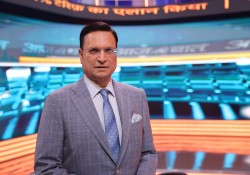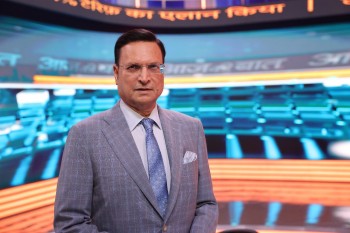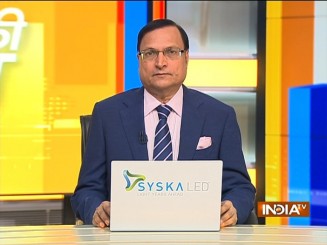
India’s quantum jump in defence : Thanks to Modi

In a massive boost to India’s defence, Prime Minister Narendra Modi’s government has embarked on major plans to acquire weapons, missiles and 5th generation stealth fighter jets.
On Thursday, India successfully tested its nuclear-capable Intermediate Range Agni-Prime missile from a rail-based mobile launcher system. This missile can reach up to 2,000 km and all corners of Pakistan can come within its range.
With this, India has joined an elite group of nations, like US, Russia, North Korea, and China, which have the capability of firing railcar-based intercontinental ballistic missiles, or ICBMs. India can now fire an ICBM from anywhere on its vast rail network spreading from Kashmir to Kanyakumari, and from Gujarat to Assam.
Former DRDO director general Hari Babu Srivastava said, the test firing of rail-based Agni Prime will send a clear message to Pakistan. Agni-Prime is the hybrid version of Agni-4 and Agni-5.
The importance of rail-based missile launcher was realized during the 12-day conflict between Iran and Israel in June this year. Israeli air force used to target all Iranian missile launchers by detecting their locations through satellites. Because of this, Iranian army had to change its locations frequently.
In a second major announcement, Prime Minister Modi said on Thursday that India and Russia will be jointly producing latest weapons. Reports suggest, India and Russia may jointly produce Sukhoi-57 fifth generation stealth fighter jets, which can evade radars. The US had offered F-35 fighter jets for sale to India. Soon after Russia offered joint production of Su-57 stealth fighter jets. Russia has also offered joint production of its S-70B combat drones which can engage enemy radars and air defence systems.
Russia wants to jointly produce S-500 Prometheus, considered one of the world’s most advanced air defence system, with India. S-500 can easily target enemy ballistic and hypersonic missiles in air. Russia has deployed S-500 air defence system in Crimea against Ukraine. It is so powerful that it can down enemy stealth fighter jets and even low-earth orbit satellites.
Russian President Vladimir Putin will be visiting India in December and chances are that India and Russia may sign some major defence deals. The ‘Sudarshan Chakra’ that PM Modi announced from Red Fort this year, includes S-500 Prometheus.
Already India and Russia are jointly producing BrahMos supersonic missiles and all its three versions are now with the armed forces. Both countries have already begun joint production of AK-203 rifles in their factory in Amethi, UP under the aegis of Indo-Russian Rifles Pvt Ltd.
Major General S K Sharma, heading this joint venture, said, 70 per cent indigenous components have been used in manufacturing AK-203 rifles. Already,18,000 AK-203 rifles have been handed over to our army in the last 18 months. 22,000 more rifles will be delivered by December this year. This company has got a contract to manufacture more than six lakh AK-203 rifles in the next ten years.
On Thursday, Defence Ministry signed one of its biggest deals, worth Rs 62,370 crore with public sector company Hindustan Aeronautics Ltd for manufacture of 68 single seater Tejas Mk-1 light combat aircraft and 29 twin seater trainer aircraft. Delivery will begin from 2027-28 onwards.
HAL CMD D. K. Sunil told India TV defence editor Manish Prasad that the first lot of 12 Tejas aircraft is almost ready and will be delivered by December. Work is now going on for Tejas Mk-2 aircraft.
It should be a matter of pride for all of us that today we are manufacturing our own fighter jets and preparing to jointly produce the latest air defence systems. In this modern age, it is essential that we become self-reliant in defence and obtain full technology transfer, so that in times of war, our armed forces will not have to be dependent on other countries.
During Operation Sindoor, India showed to the world how its BrahMos missiles can work with pinpoint precision and cause heavy damage to the enemy. The world is today sitting up to take note of our missiles.
For 60 to 65 years since Independence, nobody even thought of manufacturing weapons, missiles and fighter jets in India. Most of the attention was given to buy thousands of crores worth weapons from abroad and there used to be reports of bribes being taken in almost every defence deal.
Narendra Modi changed this entire line of thinking. He prepared a defence policy for India, where weapons and equipment will be manufactured in India and there will be technology transfer. Work has begun.
Our armed forces have a huge list of requirements. It will take time for us to be self-reliant in defence. In English, there is a saying: ‘Well begun is half done’. The missiles, rifles and fighter jets that are being made send a good signal.
Ladakh statehood : Let the talks begin
An uneasy calm prevails in Leh and Kargil after arson and violence on Wednesday that led to the death of four persons and injuries to nearly 90 people. The Home Ministry said, the violence was a result of pre-meditated political conspiracy and social activist Sonam Wangchuk was partly responsible for this.
In a 10-point statement, the Home Ministry said, Wangchuk, in his speech, had mentioned about Arab Spring-style protest and Nepal’s Gen-Z movement. This led to youths resorting to widespread arson and violence.
The ministry said, the government’s high-powered committee and sub-committees are already engaged in talks with different parties and leaders, and reservation for Scheduled Tribes in Ladakh has been raised from 45 pc to 84 pc, recruitment to 1,800 posts has begun and women have been given 33 pc reservation in local council. The statement also said, Bhoti and Purgi have been given official language status in Ladakh.
On his part, Sonam Wangchuk alleged that the Centre was trying to make him a scapegoat and he had nothing to do with violence. He said, he used the Gen-Z word in some different context, and his words were being thoroughly misinterpreted.
Wangchuk’s problems are going to increase. On Thursday, the Home Ministry revoked the FCRA licence of his NGO Students Educational and Cultural Movement of Ladakh, choking off his foreign donations. The ministry found that the NGO had already started collecting foreign donations even before it got the licence. The land lease given to Wangchuk’s NGO Himalayan Institute of Alternative Learning has been cancelled. This 1,076 canal land was leased by the government to his NGO for 40 years.
One must learn lessons from the sudden violence that gripped Ladakh. It may be that Sonam Wangchuk could have incited people, or there may be a larger conspiracy.
But we should not ignore the core issue. People of Ladakh are demanding full statehood and talks must begin. People are seeking jobs, and if recruitments begin, then people should understand this fact too. Time is not lost. The situation is under control.
The nice people of Ladakh are nice and peace loving. They believe in democracy. We should regain their trust and must not delay talks. The message must go that the government might consider their demands with full sympathy and some ways would be found out.
Get connected on Twitter, Instagram & Facebook

Ladakh violence : Conspiracy or public anger?

Curfew has been imposed in Leh town and prohibitory orders under Sec 163 BNS have been issued in Kargil, which witnessed a bandh on the call of Leh Apex Body and Kargil Democratic Alliance.
Indo-Tibetan Border Police has been deployed in Leh. At least 50 persons have been detained after mobs set fire to the BJP office in Leh and ransacked the Ladakh Autonomous Council office.
The Director General of Police, Ladakh, S. D. Singh Jamwal said, four people died, 15 others were seriously injured and 30 others sustained minor injuries during the protests.
The bandh call was given in support of the demand for immediate talks with the Centre on granting full statehood to Ladakh and extension of Sixth Schedule of Constitution.
On September 24, mobs torched several vehicles of police and CRPF forcing police to fire to quell violence. Seven companies of CRPF have been deployed in Leh and four additional CRPF companies have been sent from Kashmir to Ladakh.
Climate activist Sonam Wangchuk, who is spearheading the demand of statehood for Ladakh, was on indefinite fast since 15 days, but when the condition of two persons deteriorated, thousands of people came out and indulged in arson and stoning.
Local BJP leaders blamed a Congress councillor and Sonam Wangchuk for instigating violence. BJP IT Cell chief Amit Malviya shared a video claiming that Congress councillor Stanzin Tsepag led a mob that torched the BJP office.
Sonam Wangchuk called off his indefinite fast soon after violence spread. He said, he had nothing to do with stone throwers and arsonists.
It needs to be mentioned here that the Centre had fixed October 6 for talks between the agitators and high-powered committee. Prior to that, informal talks were to begin from September 26. Despite these firm assurances, the agitators resorted to arson and violence. It is difficult to understand any logic behind it.
The question is: Was the violence pre-planned? Were the youths instigated? This is not the right method to make the Centre accept the demands of agitators. Nobody has the right to indulge in violence in a democracy.
BJP leaders allege, the violence was instigated by Congress because the party wants to create a “Nepal-type” situation in India. Activist Sonam Wangchuk said, Congress has no strength left to amass such a huge crowd in Ladakh.
Wangchuk has condemned the violence but at the same time, he sought to justify public anger. Some others interpreted this to say, it was Wangchuk who incited the mobs to indulge in violence and then later issued an appeal for peace.
Has the movement gone out of control from Wangchuk’s hands? In spite of his opposition to violence, he could not stop the arsonists. Or, is there a larger conspiracy at work? Whatever may be the case, those who indulged in arson and violence will be rounded up and the truth will come out soon.
Bihar’s Muslims, EBC votes : The tug of war has begun
Hectic politicking is on in Bihar with the dates of assembly polls expected to be announced early next month. The Congress Working Committee met in Bihar for the first time since Independence, after a gap of 85 years. Mahagathbandhan leaders Tejashwi Yadav and Rahul Gandhi launched a 10-point programme for upliftment of Extremely Backward Castes (EBC).
AIMIM chief Asaduddin Owaisi addressed six rallies in the Muslim-dominated Seemanchal region of Bihar. Jan Suraaj Party convenor Prashant Kishor met Muslim intellectuals of that region. BJP leaders held meetings with leaders of 26 districts, while in Delhi, NDA leaders discussed seat sharing issues.
The real fight seems to be for Muslim votes. Owaisi has clearly said that since Tejashwi Yadav has refused to leave six seats to AIMIM, his party will fight to defeat RJD.
Prashant Kishor claimed, only his party can give Muslims their legitimate rights, while RJD, Congress and AIMIM want to get Muslims votes by projecting the BJP bogey. He asked Muslims not to fall in the trap of RJD or AIMIM.
Seemanchal region has only 24 assembly seats, and RJD, Janta Dal-U, Congress, Prashant Kishor and Owaisi are all angling for these seats. Owaisi’s party had won five seats in 2020, but four of his MLAs quit and joined RJD.
In most of his rallies, Owaisi said, while BJP carries out ‘Operation Lotus’ to wean away MLAs, RJD in Bihar carried out ‘Operation Lalten’ (Lantern – RJD symbol).
Chief Minister Nitish Kumar, a shrewd politician, is also angling for Muslim votes. He is touring Muslim-dominated localities and telling them what his government did for the betterment of Muslims.
In Bihar elections, political pundits agree on one point, BJP will not get Muslim votes. Secondly, it is also assumed that a large part of Muslim voters would lean towards Lalu Yadav. In the last assembly polls, Owaisi rubbished these theories by winning five seats. It’s a different matter that four of his legislators later ditched the party and joined RJD.
This time, Owaisi stood at RJD’s doors and demanded six seats. The reason is clear. He does not want his party to be dubbed as “BJP’s B team”. RJD leaders allege that Owaisi’s party indirectly helps the BJP by dividing Muslim votes. Owaisi wants to get this tag removed.
But, there is a new factor now in the shape of Prashant Kishor. He has promised to give 40 tickets to Muslim candidates. If his fledgling party gets some Muslim votes, electoral equations in Bihar will change.
RJD and Congress feel that Muslims have no other option but to support the Mahagathbandhan. The alliance’s focus is now more on Dalits and backward caste voters. Since Extremely Backward Castes constitute more than 70 per cent of backward caste voters, the RJD-led alliance held Ati Pichhda Nyay Sammelan in Patna and released a Nyaya Sankalp Patra for the upliftment of EBCs.
The common perception about EBC voters in Bihar is that a majority of them are with Nitish Kumar. This is the reason why any alliance that Nitish Kumar backs, wins the elections hands down. It is because of this that Rahul Gandhi and Tejashwi Yadav are wooing the EBCs. One must admit, Nitish Kumar has a magical sway over his supporters. Come what may, they never ditch him. This seems to be the only reason why Nitish Kumar is ruling Bihar as CM for the last two decades.
Get connected on Twitter, Instagram & Facebook

India-China Understanding: Much to learn for the West
 This year’s Diwali will be a different one for our brave jawans and officers deployed near the Line of Actual Control in eastern Ladakh. Nearly 50 per cent of troop disengagement has been completed in Depsang and Demchok by Friday evening, and the Indian Army plans to begin patrolling in coordination with the Chinese army in the two areas by October-end. Talks are going on over issues like ‘buffer zones’ which had been created earlier in the region with high altitude.
This year’s Diwali will be a different one for our brave jawans and officers deployed near the Line of Actual Control in eastern Ladakh. Nearly 50 per cent of troop disengagement has been completed in Depsang and Demchok by Friday evening, and the Indian Army plans to begin patrolling in coordination with the Chinese army in the two areas by October-end. Talks are going on over issues like ‘buffer zones’ which had been created earlier in the region with high altitude.
The disengagement in Depsang and Demchok will be over by October 28 or 29, and the patrolling from both sides, with prior intimation to avoid face-offs, will begin after mutual verification. Dismantling of temporary posts, sheds, tents and other structures and pullback of troops in Depsang and Demchok to pre-April 2020 position is going on and is being closely monitored both on the ground and from the air by using drones.
In Demchok, Indian troops are moving back towards the west from Charding Nullah, while Chinese army has withdrawn some of its vehicles after dismantling nearly a dozen temporary structures.
Two days ago, Prime Minister Narendra Modi and Chinese President Xi Jinping had discussed the border issue and it was decided to resume Special Representative level talks on solving the vexed India-China border dispute. Till last week, nobody could have imagined that troops of both sides would resume patrolling near the friction points in Ladakh so soon, and a tension-free Diwali would be celebrated by our brave jawans.
Prime Minister Modi had been roundly criticized by our opposition leaders for the last two years over the Ladakh border tension issue. Opposition leaders had been alleging that China has occupied a large part of our territory in Ladakh and Modi has “surrendered” before the Chinese. Modi never replied, nor got provoked over these allegations.
Modi preferred to work silently, used diplomatic techniques and displayed military power. He was neither in awe of the Chinese, nor did he bow down. I think Modi might have used the good offices of his friend Russian President Vladimir Putin for improving relations with China. It suits Putin if India and China join hands, and appear to stand with Russia.
Putin can then claim before the West that Russia is now a major power that is not isolated from the rest of the world. Those who have been making fun of Modi and asking questions on when he would show his “red eyes” at China, will now have red eyes.
If India-China relations improve, it will be a pain in the neck for Rahul Gandhi. Rahul will then realize that he made a mistake in trusting the Chinese more rather than believing in Modi’s claim.
The world is today abuzz with talks about the rapprochment between India and China and how the border issue in Ladakh was resolved through bilateral talks. This can be shown as an example to the European Union and other Western powers on how to bring an end to the ongoing conflicts in Ukraine and Middle East.